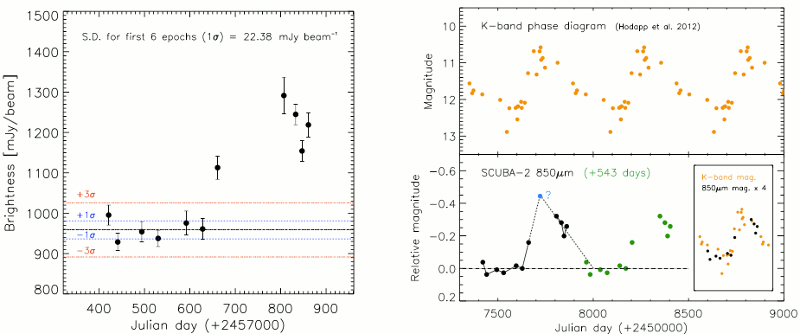
|
EPoS |
|
EPoS Contribution
|
|
The Variability of Deeply Embedded Protostars in the Sub-Millimetre
Doug Johnstone NRC HAA, Victoria, CA | |
|
We are conducting a 3-year dedicated JCMT/SCUBA-2 monitoring program of eight nearby star-forming regions to search for sub-mm brightness variations as a proxy of episodic accretion onto deeply embedded protostars. We have identified the first protostar with a periodic brightness variation at sub-mm wavelengths, EC 53 in Serpens Main. The change in sub-mm brightness of EC 53 is interpreted as dust heating in the envelope, generated by a luminosity increase of the protostar. The sub-mm light-curve resembles the historical K-band light-curve, which varies by a factor of ~6 with an 18 month period and is interpreted as accretion variability excited by interactions between the accretion disk and an embedded companion.
Furthermore, we have compared archival SCUBA-2 observations against the first year of our survey and we have performed a statistical analysis of the first eighteen months of the survey. From both these analyses we conclude that greater than 5% of the known deeply embedded protostars are found to vary in the sub-mm over several year time-scales. | |
 | |
| Caption: Left panel: The time variation of peak brightness of Source 5 (EC 53) at 850 μm. The blue and red horizontal lines indicate ±1σ and ±3σ levels (1σ ~ 22.4 mJy/beam is the standard deviation of peak brightness for the first 6 epochs) relative to the mean peak brightness over the first 6 epochs. Upper right panel: Replicated K-band lightcurve of EC 53 from the phase diagram in Figure 5 of Hodapp et al. (2012) with a period of 543 days. Lower right panel: Relative magnitude with respect to the 6th epoch (zero magnitude) observed on August 2016. The black circles are the JCMT/SCUBA-2 850 μm data points observed from February 2016 to April 2017 and the green circles are replicated 850 μm data assuming the sub-mm lightcurve has the same 543 day period as in the K-band. The blue circle indicates the expected maximum brightness, which is calculated by comparing the brightening in the 6th and 7th epochs and the decay of the last four epochs. The inset shows the 850 μm lightcurve, whose magnitude is amplified by a factor of 4, on top of the K-band lightcurve (Figure and caption taken from Yoo et al. 2017). | |
| Collaborators: G. Herczeg, Peking U, CN S. Mairs, U Victoria, CA H. Yoo, Kyung Hee U, KR J.-E. Leem, Kyung Hee U, KR The JCMT Transient Team |
Key publication
Suggested Session: Protostellar disks |